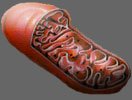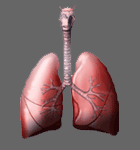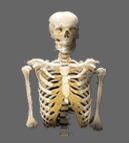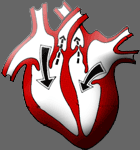The beneficial relationship between exercise/movement and good health has been known for hundreds of years. Great classical-world philosopher Plato, said it best when discussing the implications of human movement and exercise:
Clearly it is not only desirable, but imperative, that one exercise regularly. However, judging by the number of e-mails I receive, questioning the types of physiological adaptations regular exercise promote, I thought it pertinent to highlight the main ones.
Doing so will benefit the readers on two counts: one, they will become more familiar with exactly what is going on when they train, and, two, the type of program, and specific exercises needed to facilitate a specific, desirable, response, can be better understood - this should make program design, and the generation of enthusiasm for training, relatively easy.
After all, the basis of all training programs, and the imputes behind the popular periodization principal (where training is structured into specific phases to maximize performance), is physiological adaptation.

What Is Physiological Adaptation?
To increase the body's capacity for work, and efficiency of function, its physiologic systems (the integrated network, responsible for ensuring the perfect sequencing of events, for every physiological function) undergo specific adaptations in response to increasing physical demands.
The changes that occur in the context of adaptation are called variations - these result quantitatively through an increase in magnitude of a given stimulus, or qualitatively through introduction of novel or unaccustomed stimuli.
In simple terms, adaptations (for the purposes of this article) are essentially changes which accompany various types of physical movement, and they can be both acute and chronic. All training sessions are accompanied by both acute and, over time, chronic adaptations.
 Acute Adaptation
Acute Adaptation
-
Sudden temporary changes in body function, caused by physical exertion, are termed acute. These adaptations disappear soon after the cessation of the exercise session.
Examples of acute adaptations include, the doubling, or tripling, of the heart rate as it works to pump blood at a faster rate, an increase in breathing rate as the lungs work to take in more oxygen, and the significant amount of oxygen that is consumed by the muscles as they struggle to contract at a faster and, more sustained, pace.
 Chronic Adaptation
Chronic Adaptation
-
As the body progresses through days, weeks, and months of training, its structure, and function, changes to accommodate the consistent workload.
These persistent changes are the chronic adaptations that enable the body to respond more favorably to subsequent training sessions. The notion of progressive resistance, for example, underscores the importance of continually increasing the volume of a particular stimulus, when aiming to gain muscle.
Without upping the training poundage, the muscles will fail to develop, as they need not accommodate a different stimulus - and therein lies the essence of chronic physiological adaptation. Another example of a chronic adaptation to exercise is the significant improvements one makes in VO2 Max (maximal oxygen uptake), lung ventilation and resting and exercise heart rate, in the first one to three weeks of moderate to intense aerobic training.
|
|
 |
||
 |
|||

Main Adaptations
In response to any form of movement, the body undergoes a multitude of adaptations, both acute and chronic. However, there are four key adaptations (the lungs, heart, muscles and bones), and these will be expanded on next.
Chronicling every adaptation would take an entire book, and this article is largely intended to inform those who want an understanding of the key principals of adaptation, and specific examples of when, and how this occurs, in a, more concise, format. As mentioned, the main physiological adaptations to exercises occur in the:
 1: Heart, & Circulatory System.
1: Heart, & Circulatory System.
-
All forms of training result in both acute and chronic adaptations of the heart and cardiovascular system as a whole. The single biggest difference between an aerobically untrained person and one who has been training in this fashion for some time, is the size of their stroke volume (the amount of blood pumped out of the heart with each beat; 55-75 milliliters in most untrained people).
The main heart adaptation is an increase in size, as it works to accommodate a greater cardiac output from session to session. As a result, an individual's heart rate is slower at rest (another adaptation), while during training (due to a stronger heart muscle) the amount of blood output needed to sustain the workload can be achieved at a lower heart rate.
Nearly all of the five-liters-or-so-of-blood that courses though the body's 60,000 miles of blood vessels, passes through the heart each minute. A trained individual needs to pump more blood around the body so therefore has to adapt to this increase, through becoming bigger and stronger. A bigger and stronger heart is more efficient and this, in and of itself, is one of the more positive chronic adaptations associated with endurance training.
The area of the heart which undergoes the greatest degree of change is the left ventricle - the part which pumps blood to the body. This means that the heart is able to pump considerably more blood per-beat at rest (stroke volume, as mentioned). For example, a trained person will pump close to 100 milliliters of blood at rest, whereas an untrained individual will pump around 60 milliliters - in short, a larger stroke volume allows the heart to pump more slowly.
On average, ones resting heart rate decreases by one-beat-per-minute, following a two week period of aerobic training, if this type of training is followed over a 20-week period. Many of the worlds best endurance athletes have resting heart rates at below 40-beats-per-minute. The most obvious acute adaptation associated with endurance training is the increase in heart rate in proportion to the levels of training intensity. At the point of exhaustion, the maximal heart rate can be measured.
To Determine Maximal Heart Rate:
-
Subtract age from 220.
Example, a fifty-year-old would have a maximal heart rate of 170 (220-50=170).
|
 |
||
 |
|||
To achieve the beneficial adaptation of increased stroke volume, and strength and size of the heart, it is recommended that one train at 60 to 90 percent of their maximal heart rate. As any beginner would know, these adaptations occur pretty rapidly at first. However, after a few months of training at 60-90% of maximal heart rate, the same higher intensity work is accomplished at a lower heart rate, and a greater training stimulus is needed to continue making similar improvements/adaptations in heart function.
A further, chronic, adaptation, stemming from improvements in stroke volume, is the amount of blood circulating in the body. Trained individuals, generally, have around half-a-liter more of blood than the average, untrained, person. Also, blood vessels (the arteries which transport blood to the body and veins which enable it to return to the heart) will become more adept at, constricting, relaxing, and dilating, in response to an increased blood flow.
As these blood vessels are comprised primarily of muscle, they, in fact, become stronger and more pliable with exercise - another chronic adaptation.
As noted, more blood can be pumped out during maximal exercise (and this includes intensive weight training), in an aerobically trained person. This results in increased oxygen to the muscles, which, in turn, improves ones VO2 Maximum (maximal oxygen intake), over the long term. The two factors responsible for this are the greater heart-blood output and increased oxygen consumption by the muscle cells. Another good reason for bodybuilders to train aerobically.
 2: Muscles.
2: Muscles.
-
As mentioned in the preceding section, VO2 maximum - maximal oxygen uptake - is dependant to some degree on the muscles ability to extract oxygen. This adaptation is one of the primary muscular changes, resulting from regular exercise. An aerobically trained muscle has more capillaries and mitochondria (energy organelles within the muscle cell), a greater capacity to store fuel (carbohydrates, glycogen and fats), more energy producing enzymes, and increased levels of myoglobin (a molecule which shuttles oxygen into the mitochondria).
 |
Mitochondria The spherical or elongated organelles in the cytoplasm of nearly all eukaryotic cells, containing genetic material and many enzymes important for cell metabolism, including those responsible for the conversion of food to usable energy. The spherical or elongated organelles in the cytoplasm of nearly all eukaryotic cells, containing genetic material and many enzymes important for cell metabolism, including those responsible for the conversion of food to usable energy. Also called chondriosome. |
 |
 |
||
The main muscular adaptation, resulting from strength training, is the increase in fast-twitch muscle fibers (dense muscle fibers with greater contractile abilities), while the aforementioned aerobic training helps to establish the slow-twitch variety (fibers with a larger percentage of mitochondria, which are more resistant to fatigue).
With long-term aerobic training, the muscles become more adept at using fats for fuel. A more aerobically fit person can supply to the muscles, the additional oxygen needed to utilize fat for fuel. It is in this context that muscle can be viewed as a key component in terms of increasing ones maximal oxygen uptake.
As mentioned, with regular aerobic exercise the slow-twitch muscles will increase in size. However, the number of these fibers will not alter - elite endurance athletes typically are born with a greater percentage of these fibers, and they train them in such a way to reach their maximum potential.
Myoglobin content within the muscle will increase by as much as 75 to 80 percent in an aerobically trained person. In order to burn fuel, and produce energy, it is imperative that the muscle have a sufficient supply of this molecule - myoglobin transports oxygen into the mitochondria.
One chronic adaptation that occurs in the muscles with consistent aerobic training is the increase in the amount of capillaries (the smallest blood vessels) surrounding each muscle. The muscles function more efficiently when they have a means in which to transfer oxygen and fuel, and remove carbon dioxide and heat (main waste products) - a large capillary network will ensure all these things happen.
Of greater relevance for bodybuilders, weight training will lead to some pretty significant adaptations. For a start, fast-twitch fibers will increase size, and this causes the muscles to take on a bulked up, powerful, look. Furthermore, the total muscle protein content will increase as will the size and strength of ligaments, tendons and other connective tissues. Furthermore, weight training will improve ones lean body mass, and accelerate the metabolism, which will lead to losses in body fat.
The main cardiovascular responses to weight training include an acute elevated heart rate and blood pressure. Chronic responses include, an increase in thickness in the hearts left ventricle wall.
 3: Lungs.
3: Lungs.
-
The harder muscles work, during a training session, the more oxygen they need. This means that more air must be taken into the lungs, and as one becomes fitter, the lungs become more adept at ventilating larger volumes of air during intense physical exertion, although the lungs typically will not grow any larger as a result of aerobic training.
 |
The Lungs The lungs of mammals have a spongy texture and are honeycombed with epithelium having a much larger surface area in total than the outer surface area of the lung itself. The lungs of humans are typical of this type of lung. The lungs of mammals have a spongy texture and are honeycombed with epithelium having a much larger surface area in total than the outer surface area of the lung itself. The lungs of humans are typical of this type of lung. Breathing is largely driven by the diaphragm below, a muscle that by contracting expands the cavity in which the lung is enclosed. The rib cage itself is also able to expand and contract to some degree. |
 |
 |
||
Furthermore, aerobically fit people will transport, and use, the oxygen they take in more efficiently, therefore allowing the lungs to work as a lower rate. The lungs of the untrained work much harder due to comparatively limited oxygen ventilation abilities.
During exercise the lungs adapt to the increase in workload by taking in large amounts of air, so that enough oxygen can be extracted for the working muscles (ordinary air is only about 21% oxygen).
At rest, most humans need about 250 milliliters of oxygen a minute, while during exercise 3700, on average, is needed - this means that up to 240 liters of air is needed per minute to extract this amount of oxygen.
Ultimately, the more air a person can take into their lungs, the greater they can train maximally.
Untrained people cannot take in as much air per minute as a trained individual. Therefore, the main adaptation in terms of lung function, an athlete experiences, is an increase in the amount of air taken in with each breath. The interesting thing is, a trained individual, although able to take in more oxygen than the average person, actually ventilates less air while achieving the same oxygen intake and intensity of exercise, as their bodies are more efficient at transporting and utilizing oxygen.
A ventilation reserve, that can be used for maximal aerobic exertion, is thus provided. The lungs are not considered a limiting factor as far as bringing oxygen into the blood goes. If anything, the heart will prevent oxygen from reaching the muscles, as it controls stroke volume (as mentioned earlier).
 4: Bones.
4: Bones.
-
The key training adaptation relating to the skeletal system, involves the process of remodeling (when cells called osteoclasts break down old bone as cells called osteoblasts replace it with new tissue to make it denser and stronger).
- The axial skeleton (vertebral column, ribs, skull, and sternum).
- The appendicular skeleton (the long bones of the upper and lower body, shoulders, hips, and pelvis).
When one exercises, in any form, but with resistance in particular, muscles contract against bone, and the bone becomes stronger through the aforementioned process of remodeling, in response to this stimuli. The bone becomes stronger as proteins form a matrix between the bone cells - a process called calcification.
New growth occurs, firstly on the outside of the bone, to allow for new cells to continue their bone-building role, with what limited space is left inside the bone itself. The main bone adaptations take place at the following sites:
 |
The Skeletal System An internal skeletal system consists of rigid structures within the body, moved by the muscular system. If the structures are mineralized or ossified, as they are in humans and other mammals, they are referred to as bones. An internal skeletal system consists of rigid structures within the body, moved by the muscular system. If the structures are mineralized or ossified, as they are in humans and other mammals, they are referred to as bones. Cartilage is another common component of skeletal systems, supporting and supplementing the skeleton. The human ear and nose are shaped by cartilage. Some organisms have a skeleton consisting entirely of cartilage and without any calcified bones at all, for example sharks. The bones or other rigid structures are connected by ligaments and connected to the muscular system via tendons. |
 |
 |
||

Selye's General Adaptation Syndrome
Adaptation was explained in elegant detail by famous Viennese physician and endocrinologist Hans Selye, in his monumental 1946 paper The general adaptation syndrome and the diseases of adaptation. Selye explained that stress can eventually lead to a chronic deleterious adaptation, in the form of infection, illness, disease and death - three stages led to this occurrence.
This landmark study describes the opposite of what athletes should be aiming for, but provides a good explanation of the concept of adaptation, nonetheless.
 Stage One: Alarm.
Stage One: Alarm.
-
During this stage an immediate physical reaction involving adrenaline and an increase in heart rate (often termed the fight or flight syndrome) resulted when his subjects were threatened or surprised.
The immune system and digestive system was found to be immediately compromised in light of this stimulus, to compensate for the more pressing emotional and muscular needs. As a result, the immune system became depressed and the body is was susceptible to illness, he found.
 Stage Two: Resistance.
Stage Two: Resistance.
-
The immune system keeps fighting, at abnormally high levels, to maintain a degree of control over the stressors we feel we are becoming used to. However, this is short lived as we can only adapt to the increases in stress for a short period.
 Stage Three: Exhaustion.
Stage Three: Exhaustion.
-
Finally, our bodies give up on trying to maintain high levels of stress, and illness invariably occurs. The fighting of this, no win, situation may even lead to death, as the body literally breaks down.
Thus, Hans Selye demonstrated that with a continued stressor, the body will eventually adapt, with disastrous results.

Conclusion
The human body undergoes a series of adaptations, in response to exercise, that promote health and well-being, and underscore the importance of regular physical activity.
The heart, muscles, lungs and bones are all positively effected by the various types of physical movement, and knowing the extent to which exercise benefits this wide range of functions will enable one to better plan their fitness programs, and continue their training with a high degree of motivation.
References
- Selye, Hans (1946). The general adaptation syndrome and the diseases of adaptation. Journal of Clinical Endocrinology 6:117-230
- Selye, Hans (1952). The Story of the Adaptation Syndrome. Montreal, Quebec, Canada: Acta Inc.
- Nieman, D.(1998). The Exercise/Health Connection. Human Kinetics Publishers: USA.

